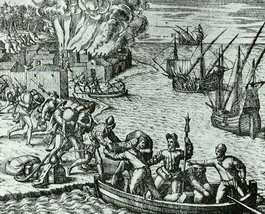1555 in France
| |||||
| Decades: |
| ||||
|---|---|---|---|---|---|
| See also: | |||||

Events from the year 1555 in France.
Incumbents
- Monarch: Henry II
Events
- 26 March - Amboise ordinance punishing with a 1,000 pounds fine usurpers of nobility in France.[1]
- 23 May - Election of Paul IV (Gian Pietro Carafa), 223rd Pope of the Catholic Church (end of the pontificate in 1559).[2] He succeeds Pope Marcellus II, dead after 22 days of reign. He reforms the Dataria and the Inquisition. Coming from an ancient Neapolitan family, traditionally hostile to the Aragonese, he makes an alliance with the King of France to expel the Habsburgs from Naples.
- 25 May - Antoine de Bourbon (1518–1562) and Jeanne d'Albret become king and queen of Navarre.[3]
- 10 July - 5 August[4] - Jacques de Sores, in the head of a French fleet, burns and pillages Havana and the Castillo de la Real Fuerza that the Governor Hernando de Soto had built to counter acts of piracy.
- 15 and 16 July - The French troops are defeated by the Imperials during the battles of Gimnée and Givet, on the border of Netherlands, and must withdraw.[5]
- 15 August - Nostradamus, invited by the queen, arrives in Paris[6][7] after passing Lyon.[8] He is received at the Court, in Paris and Blois.
- 10 November - In Brazil, a French expedition strong of three ships[9] and 600 colonists and directed by Nicolas Durand de Villegaignon, lord of Torcy and vice-admiral of Brittany, settles in the bay of Rio de Janeiro, to constitute the starting point of a Protestant[9] colony called "France Antarctique" (Antarctic France).[10] Around Guanabara, where the colony settles, two tribes, the Tupinambás and the Margaïas fight each other continuously, submitting their respective prisoners to the worst abuse.[11] The colony of Fort Coligny, built by Villegaignon and his nephew Legendre de Boissy[9] on the Villegaignon island, will be destroyed by the Portuguese on 16 March 1560.[9][12]
- Nostradamus publishes his Centuries.[13]
- The first Reformed Churches are created.[14] Nobles begin to join the Protestant movement.[15]
- The French troops ransack the Couvin castellany, in Belgium.[16]
- Ami Perrin leads, in Geneva, an unsuccessful riot intended to expel the French religious refugees from the city.[17]
- Jean Calvin sends Jacques l'Anglois from Geneva to the reformed church of Poitiers. The latter is the first Calvinist missionary in France.[18]
Births

- 18 March, at the Palace of Fontainebleau - Francis, Duke of Anjou, Alençon, Touraine, Brabant and Château-Thierry, youngest son of Henry II and Catherine de' Medici († 10 June 1584, in Château-Thierry).
- 6 July - Louis II, Cardinal of Guise, archbishop-duke of Reims from 1574 to 1588 († 24 December 1588).
- 28 September – Henri de La Tour d'Auvergne, vicomte de Turenne, duc de Bouillon, Marshal of France († 1623).
Full date unknown
- François de Malherbe, poet († 1628).
Deaths
- 14 January – Jacques Dubois, anatomist (b. 1478)
- 25 May - Henri d'Albret (b. 1503)
Notes
- ↑ de La Roque de la Lontière, Gilles A. (1734). Traité de la noblesse et de toutes les differentes especes. Rouen.
- ↑ Darras, Joseph Épiphane (1854). Histoire générale de l'Église. Vives.
- ↑ Levantal, Christophe (1996). Ducs et pairs et duchés-pairies laïques à l'époque moderne (1519-1790). Maisonneuve & Larose. ISBN 9782706812194.
- ↑ Friederici, Georg (1967). Caráter da descoberta e conquista da América pelos Europeus. Ministério da Educação e Cultura, Instituto Nacional do Livro, Seção de Publicações.
- ↑ Lartigue, J.; Le Catte, A. (1868). Givet. Recherches historiques. F. Choppin.
- ↑ Hatton, Claude. Mémoires.
- ↑ Nostradamus. Présages pour l’an 1557.
- ↑ Guéraud, Jean. Chronique lyonnaise.
- 1 2 3 4 November 10, 1555 - The failed dream of an Antarctic France.
- ↑ Hugo, Abel (1841). France historique et monumentale : Histoire générale de France depuis les temps les plus reculés jusqu'à nos jours. 4. Delloye.
- ↑ Prévost, Antoine François (1758). Histoire générale des voyages. 54. Didot.
- ↑ New France (was Quebec, not a part of Canada).
- ↑ Biography of Nostradamus: At the Court of France (1555).
- ↑ Bernard, Roussel (1994). ""Faire la Cène" dans les églises réformées du royaume de France au seizième siècle (CA 1555-CA 1575)". Archives de sciences sociales des religions. EHESS. 85: 99–119. JSTOR 30128905.
- ↑ Kingdon, Robert McCune (2007). Geneva and the Coming of the Wars of Religion in France: 1555-1563. Geneva: Droz. ISBN 978-2-600-01203-4. Retrieved 29 January 2013.
- ↑ Blondeau, P. (1984). Au pays des Rièzes et des Sarts. p. 38.
- ↑ Histoire de Genève des origines à 1798, publiée par la Société d'histoire et d'archéologie de Genève. Geneva. 1951. pp. 248–250.
- ↑ Geneva, Arch., Registres de la Compagnie des Pasteurs, vol. B2, fol. 22v.
References
- Baguenault de Puchesse, G. (1879). La politique de Philippe II dans les affaires de France 1555-1598. Revue des Questions historiques.
- Schmidt, A. M. (1938). La poésie scientifique en France au seizième siècle.
- Benedict, P. (1996). Tolerance and intolerance in the European reformation.
- Ruffin, Jean-Christophe (2001). Rouge Brésil. Paris: Gallimard.
- Lestringant, Frank (2004) [1990]. Le Huguenot et le sauvage: l'Amérique et la controverse coloniale, en France, au temps des guerres de religion. Titre courant (in French). 27 (3 ed.). Geneva: Droz. ISBN 978-2-600-00527-2. Retrieved 28 January 2013.
See also
This article is issued from Wikipedia - version of the 9/23/2016. The text is available under the Creative Commons Attribution/Share Alike but additional terms may apply for the media files.

